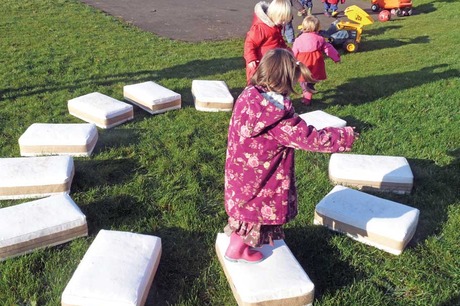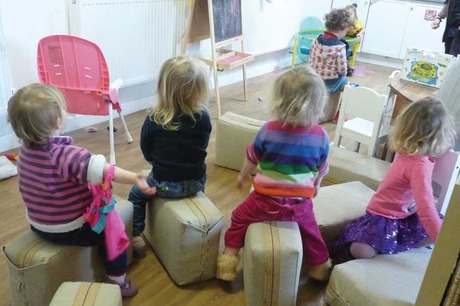children the power to bring imaginary worlds to life. Michael Follett
suggests handing over creative control.

Have you ever wondered why children love to build a tower of blocks and then knock it down again? What looks like a simple activity and a simple resource enables them to explore and develop much more than would appear at first sight, including strength, co-ordination, narrative, literacy, language, co-operation, negotiation, self-confidence, empowerment and intelligence.
Block play is appealing to children on many levels. Large blocks such as wood, cardboard or bales present the physical challenge of manipulation - getting your arms around them, lifting, dragging, tipping and transporting are challenging and rewarding actions.
Often, large blocks become the catalyst for group co-operative activity, either in the desire to move quantities of them or the desire to perform a task such as a large building project that would be easier and quicker with some help.
The fact that there are a plentiful supply of identical units enables social play to begin in parallel play, where children play with units alongside each other.
Play spreads out from solitary players as other children observe what their peers are doing with their blocks and copy and adapt these ideas. Parallel play may easily evolve into co-operative play as children form joint enterprises, ask each other for help or become excited and share ideas.
A key early skill children develop in their play is 'symbolism' (Piaget symbolic play) in which they assign a symbolic meaning to an object, so a stick becomes a wand or a block becomes a pony. One of the joys of simple blocks is their open-endedness; they can be assigned almost any meaning turning within a moment, from a suitcase to a shark.

QUALITIES OF THE MATERIALS
Children are attuned to the qualities of the materials they play with; their senses have a strong awareness of colour, texture, smell, softness, flexibility and sound.
This is especially true with large block play as children are physically close to the blocks when they play - they lie on them, hug them, sit on them, smell them and touch them all the time. A rich play environment will have a rich variety of materials for children to experience.
Language is stimulated by need; when children are playing with large blocks, there is strong need to communicate with other players for many reasons such as: requests for assistance, agreement about what symbolises what (is it a baby or a table?), and gaining consensus on how the narrative will develop (often preceded by 'Let's pretend'). Development of narrative skills and, therefore, literacy are rooted in the children's ability to create the living narrative of their imaginative play.
With a plentiful supply of simple blocks a child can reshape the outside world to reflect the imaginative world that is unfolding within: a wall falls over and becomes a bridge, which becomes a boat; part of the boat becomes a table.
Practitioners observing solitary imaginative play will often hear children conduct a spoken commentary on the developing narrative, either mouthing words, speaking to inanimate objects or talking to themselves.
When they play together, children delight in sharing their narratives with each other, and this becomes a rich source for use of language as they explain to each other that the boat has a hole and is sinking, the baby is hungry or the table is now a pig and has run away.
As soon as other people are involved in imaginative play, more words are needed to describe what is happening and negotiation is required, as there will be different views and opinions about what is happening and what is going to happen next.

RESHAPING THE LANDSCAPE
Large block play provides a unique set of opportunities for development that is quite different from either small object play or playing within a fixed landscape or equipment because with large blocks children are able to reshape the landscape. They are able to alter topography and create hills, steps, tunnels and walls; they can make machines that many people can travel in and they can create buildings that are partly in the imagination but also partly real, such as castles, shops and cafes.
This relationship between the individual and the physical world is about motivation and power. If a child can build something big it is a very empowering experience - the transference of an idea into a reality.
The ability to be creative is seen as one of the fundamental conditions for happiness and well-being and one of the reasons why humans have been such a successfully adaptive species. For young children, whose every experience is controlled by more powerful adults, the ability to extend creation into destruction is also a very empowering experience.
Destroying a deliberately temporary creation of your own is one of the few acceptable ways children can experience powerful control over the world around them, hence the delight in pushing over a tower of blocks that even the youngest babies demonstrate.
Early years practice in the UK recognises the importance of 'learning by doing' as well as learning by being told. Self-directed action is important because it is at the point when children are agents of their own enquiry and intrinsically motivated to do what they do that they are open to learning involving the development of intelligence as opposed to learning based on absorbing data.
Large block play is one of the most flexible ways of giving children expressive and creative control over their environment, allowing them to create and re-create their world and evolve ideas - building not just in the physical sense but building language, social skills and communication.
Michael Follett has worked as a playworker, special needs worker, early years teacher and school improvement adviser. He now runs OPAL Outdoor Play and Learning, supporting primary schools and other organisations in creating the conditions for great play to flourish.
He designed the outdoor play spaces for Bristol's three Early Excellence Centres and in the recent years has spoken on play in the USA, Dubai, New Zealand and Turkey. He has worked as play adviser to the Big Lottery and the National Institute for Heath and Care Excellence (NICE) and more recently the FA and the National Trust. He worked with Playgarden to create Playbales, a straw-based play block.
THE DEVELOPMENT OF PLAYBALES
Talking about the inspiration for Playbales, a straw-based play block that he created in partnership with Playgarden, Mr Follett says, 'I was influenced by childhood memories of playing on my aunt's farm in Somerset.
'I wanted young children to enjoy being able to build with bales that feel, smell and sound as near as possible to the bales of hay I used to play with in the barn.
'Using natural straw sealed in natural canvas covers with jute handle straps gives much the same experience that my cousins and I had hefting bales around by the baler twine, but scaled down for much younger children.
'I also wanted children to play with a soft large block that is not made of plastic and foam, does not have a harmful impact on the environment and can easily be composted and recycled.'
 BLOCK PLAY: FURTHER READING
BLOCK PLAY: FURTHER READING
- Exploring Learning: young children and block play, edited by Pat Gura with the Froebel Blockplay Research Group, directed by Tina Bruce (Paul Chapman) - an interpretative account of collaborative action-research into children's block play during a three-year project.
- Building Structures with Young Children by Ingrid Chalufour and Karen Worth (Young Scientist Series, Redleaf Press)
- Resourcing and scaffolding block play at: journeyinto earlychildhood.weebly.com/the-importance-of-block-play.html
Visit www.nurseryworld.co.uk to view:
- 'All about ... block play' by Anne O'Connor - an essential guide to this most versatile and open-ended play material, which provides opportunities for learning across all the areas of the curriculum and should be an essential item in all early years settings.
- 'Making spaces ... block play' by Anne O'Connor - how to make the most of block play for two-year-olds.
- 'Making spaces ... symbolic play' by Anne O'Connor - tuning in to children's imaginative play encourages language development.
- 'Practice in pictures ... block play' by Anne O'Connor - how block play allows a child to mix creativity with mathematical problem-solving.
- 'Our bright idea: block play' by Jean Evans - sharing the benefits of block play with parents.
- 'Stacking up' by Daniel Spry, Pauline Latchford and Annabel Hollis - how a research project brought a deeper understanding of children's block play and significant improvements in practice.
- 'Open-ended play: I made a unicorn' by Helen Huleatt, Prof Tina Bruce, Lynn McNair, Sian Wyn Siencyc (see also www.communityplaythings.co.uk/learning-library/training-resources/ i-made-a-unicorn).









